Cross-Cultural Management Report: HG Dam Project, Tanzania Operation
VerifiedAdded on 2023/01/11
|12
|3389
|2
Report
AI Summary
This report analyzes cross-cultural management strategies for Hydro Generation's dam project in Tanzania, focusing on the challenges of managing diverse cultures within the workplace. It explores organizational culture, including Handy's Culture Model, and its impact on employee behavior. The report also examines various leadership theories, such as situational, transformational, servant, and contingency leadership, and their relevance to the project. Furthermore, it discusses the importance of motivation and human resource management (HRM) in fostering a productive and harmonious work environment. The report provides recommendations for Graham Steinberg, the vice president of Hydro Generation, to effectively manage cross-cultural issues, improve employee performance, and achieve project objectives.
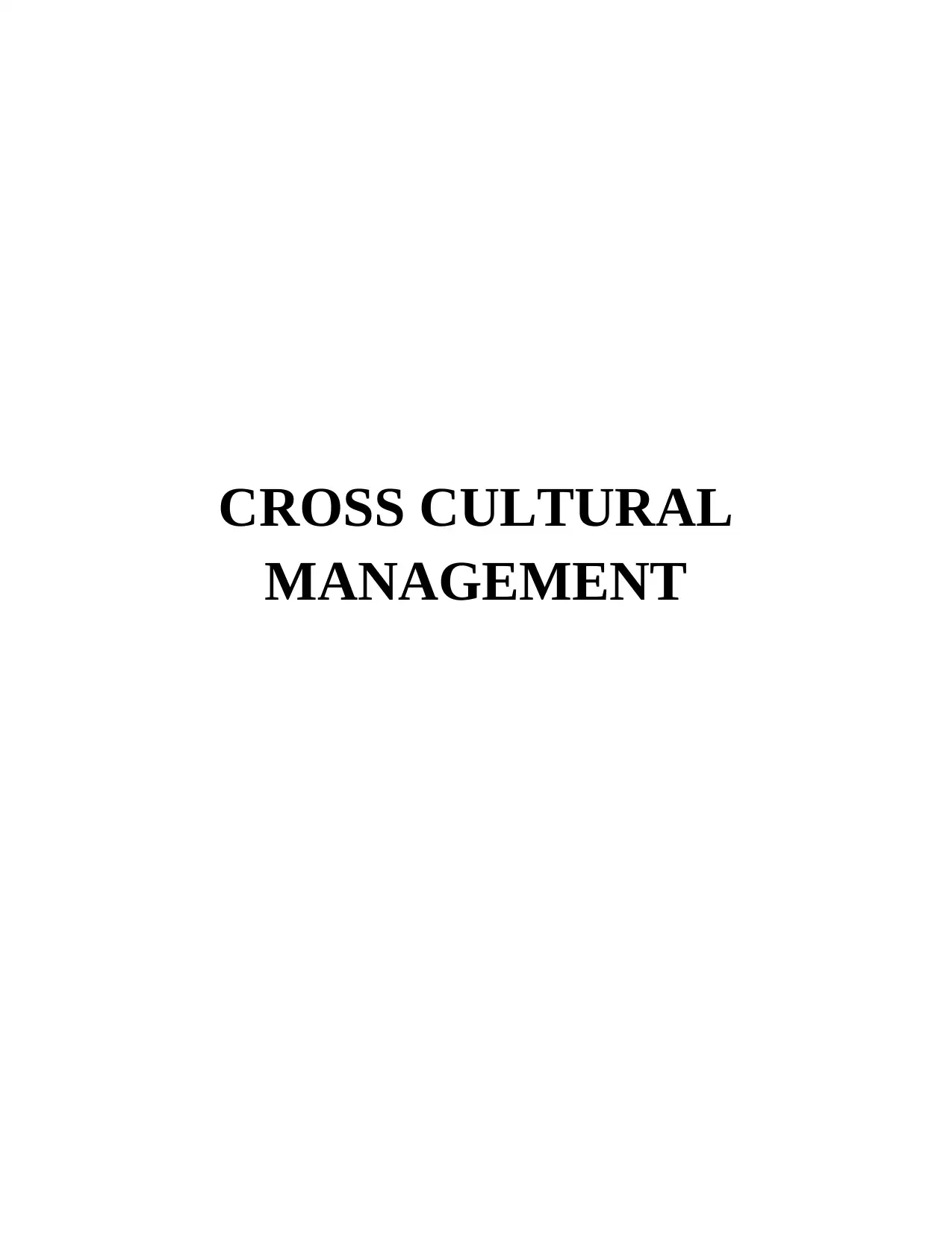
CROSS CULTURAL
MANAGEMENT
MANAGEMENT
Paraphrase This Document
Need a fresh take? Get an instant paraphrase of this document with our AI Paraphraser
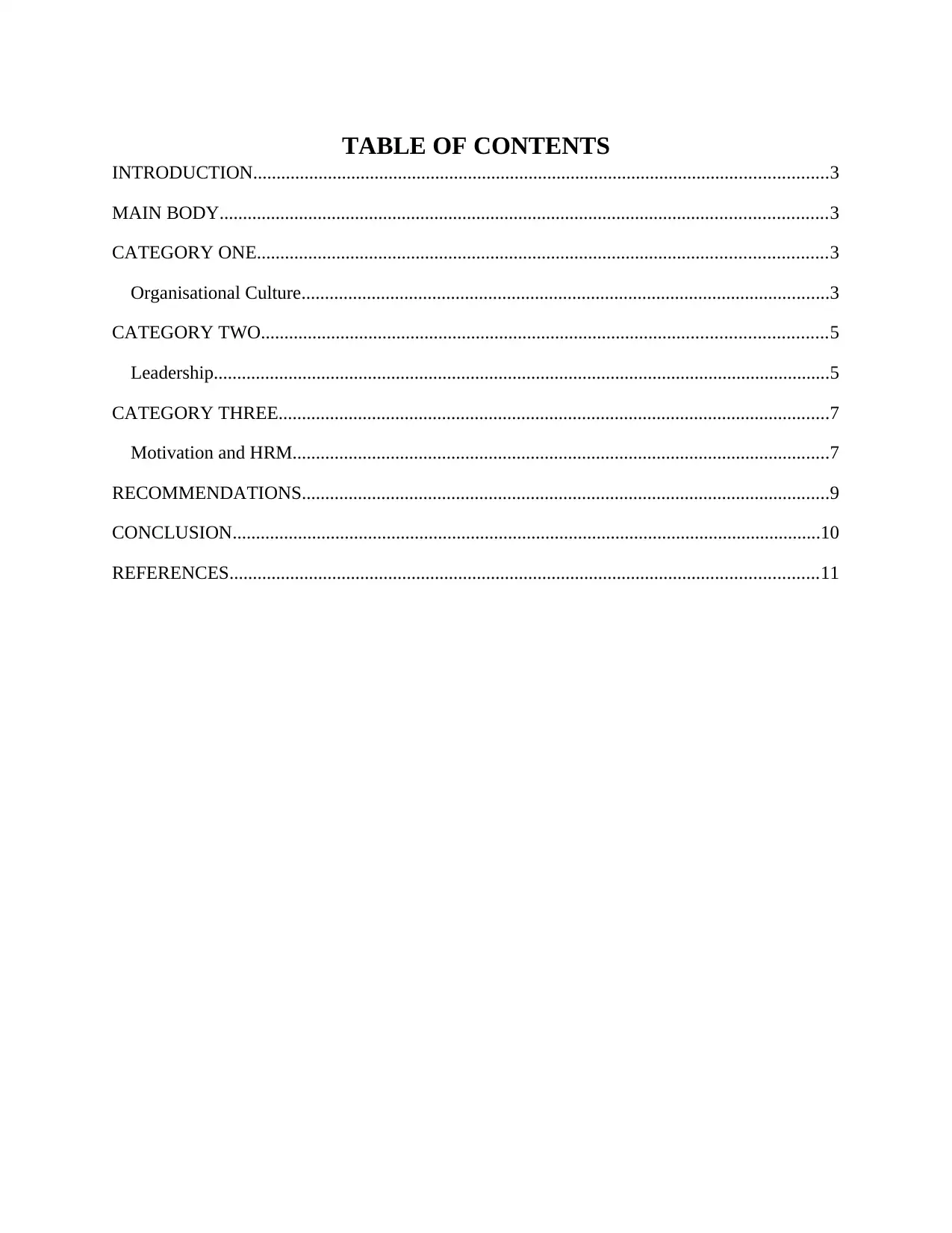
TABLE OF CONTENTS
INTRODUCTION...........................................................................................................................3
MAIN BODY..................................................................................................................................3
CATEGORY ONE..........................................................................................................................3
Organisational Culture.................................................................................................................3
CATEGORY TWO.........................................................................................................................5
Leadership....................................................................................................................................5
CATEGORY THREE......................................................................................................................7
Motivation and HRM...................................................................................................................7
RECOMMENDATIONS.................................................................................................................9
CONCLUSION..............................................................................................................................10
REFERENCES..............................................................................................................................11
INTRODUCTION...........................................................................................................................3
MAIN BODY..................................................................................................................................3
CATEGORY ONE..........................................................................................................................3
Organisational Culture.................................................................................................................3
CATEGORY TWO.........................................................................................................................5
Leadership....................................................................................................................................5
CATEGORY THREE......................................................................................................................7
Motivation and HRM...................................................................................................................7
RECOMMENDATIONS.................................................................................................................9
CONCLUSION..............................................................................................................................10
REFERENCES..............................................................................................................................11
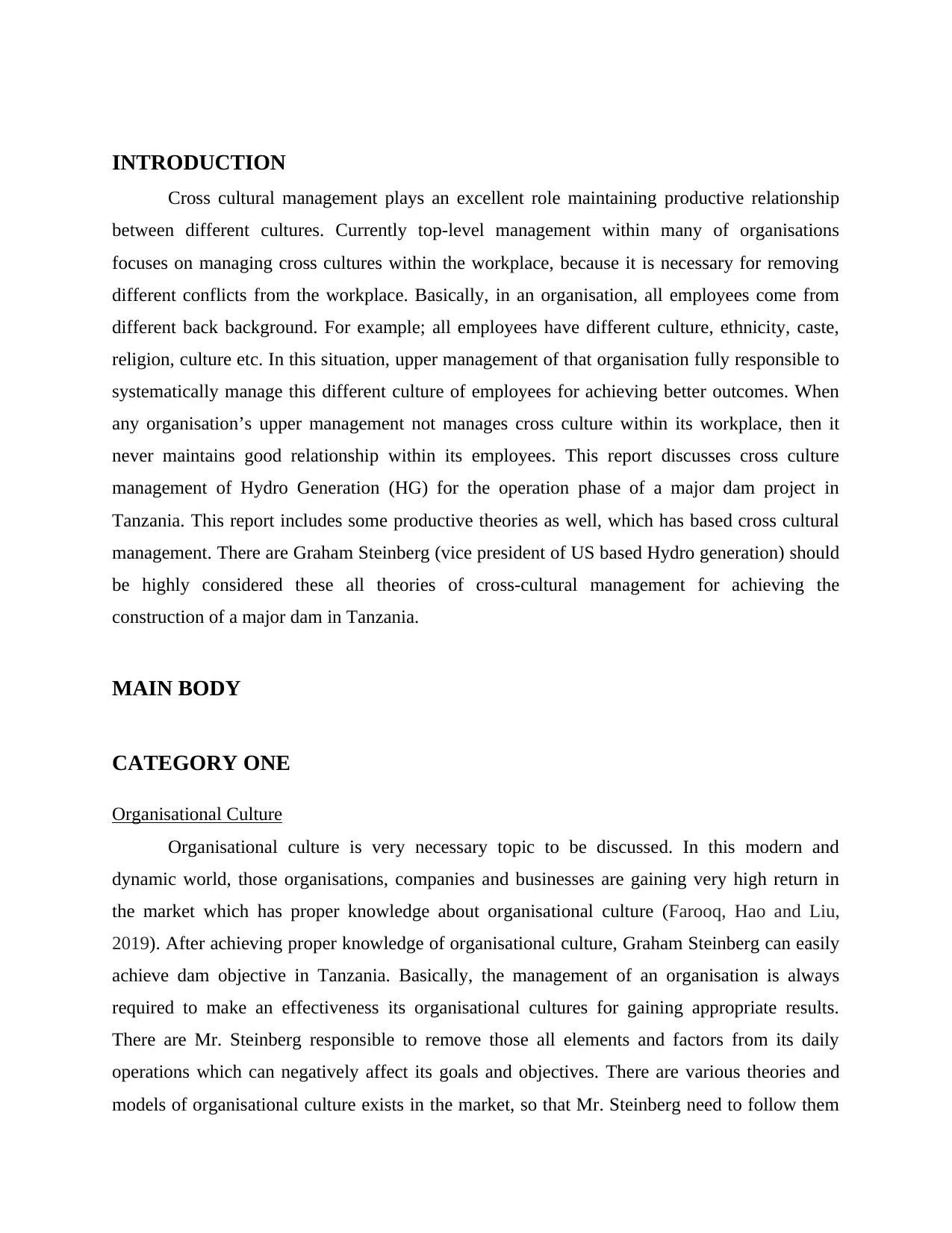
INTRODUCTION
Cross cultural management plays an excellent role maintaining productive relationship
between different cultures. Currently top-level management within many of organisations
focuses on managing cross cultures within the workplace, because it is necessary for removing
different conflicts from the workplace. Basically, in an organisation, all employees come from
different back background. For example; all employees have different culture, ethnicity, caste,
religion, culture etc. In this situation, upper management of that organisation fully responsible to
systematically manage this different culture of employees for achieving better outcomes. When
any organisation’s upper management not manages cross culture within its workplace, then it
never maintains good relationship within its employees. This report discusses cross culture
management of Hydro Generation (HG) for the operation phase of a major dam project in
Tanzania. This report includes some productive theories as well, which has based cross cultural
management. There are Graham Steinberg (vice president of US based Hydro generation) should
be highly considered these all theories of cross-cultural management for achieving the
construction of a major dam in Tanzania.
MAIN BODY
CATEGORY ONE
Organisational Culture
Organisational culture is very necessary topic to be discussed. In this modern and
dynamic world, those organisations, companies and businesses are gaining very high return in
the market which has proper knowledge about organisational culture (Farooq, Hao and Liu,
2019). After achieving proper knowledge of organisational culture, Graham Steinberg can easily
achieve dam objective in Tanzania. Basically, the management of an organisation is always
required to make an effectiveness its organisational cultures for gaining appropriate results.
There are Mr. Steinberg responsible to remove those all elements and factors from its daily
operations which can negatively affect its goals and objectives. There are various theories and
models of organisational culture exists in the market, so that Mr. Steinberg need to follow them
Cross cultural management plays an excellent role maintaining productive relationship
between different cultures. Currently top-level management within many of organisations
focuses on managing cross cultures within the workplace, because it is necessary for removing
different conflicts from the workplace. Basically, in an organisation, all employees come from
different back background. For example; all employees have different culture, ethnicity, caste,
religion, culture etc. In this situation, upper management of that organisation fully responsible to
systematically manage this different culture of employees for achieving better outcomes. When
any organisation’s upper management not manages cross culture within its workplace, then it
never maintains good relationship within its employees. This report discusses cross culture
management of Hydro Generation (HG) for the operation phase of a major dam project in
Tanzania. This report includes some productive theories as well, which has based cross cultural
management. There are Graham Steinberg (vice president of US based Hydro generation) should
be highly considered these all theories of cross-cultural management for achieving the
construction of a major dam in Tanzania.
MAIN BODY
CATEGORY ONE
Organisational Culture
Organisational culture is very necessary topic to be discussed. In this modern and
dynamic world, those organisations, companies and businesses are gaining very high return in
the market which has proper knowledge about organisational culture (Farooq, Hao and Liu,
2019). After achieving proper knowledge of organisational culture, Graham Steinberg can easily
achieve dam objective in Tanzania. Basically, the management of an organisation is always
required to make an effectiveness its organisational cultures for gaining appropriate results.
There are Mr. Steinberg responsible to remove those all elements and factors from its daily
operations which can negatively affect its goals and objectives. There are various theories and
models of organisational culture exists in the market, so that Mr. Steinberg need to follow them
⊘ This is a preview!⊘
Do you want full access?
Subscribe today to unlock all pages.

Trusted by 1+ million students worldwide
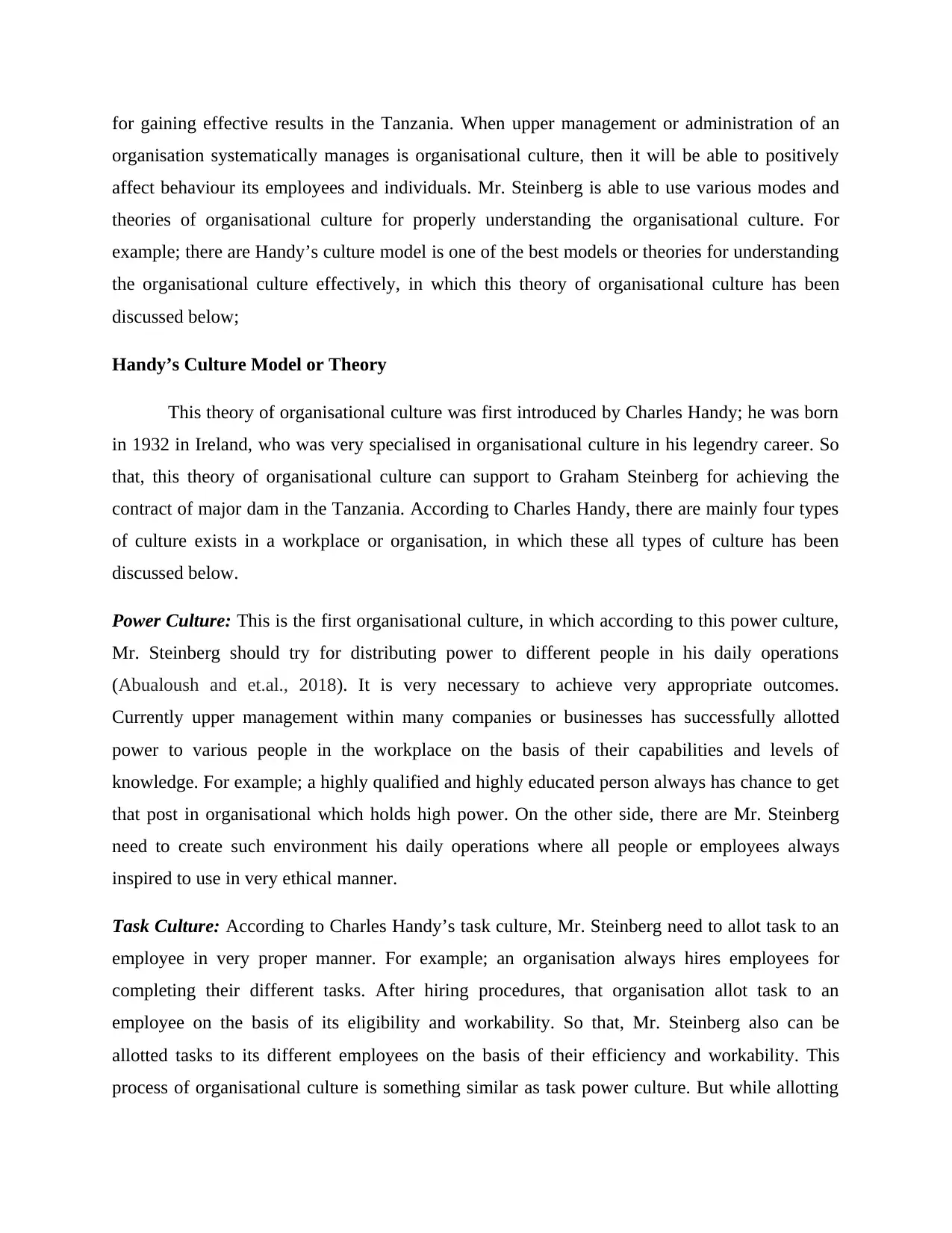
for gaining effective results in the Tanzania. When upper management or administration of an
organisation systematically manages is organisational culture, then it will be able to positively
affect behaviour its employees and individuals. Mr. Steinberg is able to use various modes and
theories of organisational culture for properly understanding the organisational culture. For
example; there are Handy’s culture model is one of the best models or theories for understanding
the organisational culture effectively, in which this theory of organisational culture has been
discussed below;
Handy’s Culture Model or Theory
This theory of organisational culture was first introduced by Charles Handy; he was born
in 1932 in Ireland, who was very specialised in organisational culture in his legendry career. So
that, this theory of organisational culture can support to Graham Steinberg for achieving the
contract of major dam in the Tanzania. According to Charles Handy, there are mainly four types
of culture exists in a workplace or organisation, in which these all types of culture has been
discussed below.
Power Culture: This is the first organisational culture, in which according to this power culture,
Mr. Steinberg should try for distributing power to different people in his daily operations
(Abualoush and et.al., 2018). It is very necessary to achieve very appropriate outcomes.
Currently upper management within many companies or businesses has successfully allotted
power to various people in the workplace on the basis of their capabilities and levels of
knowledge. For example; a highly qualified and highly educated person always has chance to get
that post in organisational which holds high power. On the other side, there are Mr. Steinberg
need to create such environment his daily operations where all people or employees always
inspired to use in very ethical manner.
Task Culture: According to Charles Handy’s task culture, Mr. Steinberg need to allot task to an
employee in very proper manner. For example; an organisation always hires employees for
completing their different tasks. After hiring procedures, that organisation allot task to an
employee on the basis of its eligibility and workability. So that, Mr. Steinberg also can be
allotted tasks to its different employees on the basis of their efficiency and workability. This
process of organisational culture is something similar as task power culture. But while allotting
organisation systematically manages is organisational culture, then it will be able to positively
affect behaviour its employees and individuals. Mr. Steinberg is able to use various modes and
theories of organisational culture for properly understanding the organisational culture. For
example; there are Handy’s culture model is one of the best models or theories for understanding
the organisational culture effectively, in which this theory of organisational culture has been
discussed below;
Handy’s Culture Model or Theory
This theory of organisational culture was first introduced by Charles Handy; he was born
in 1932 in Ireland, who was very specialised in organisational culture in his legendry career. So
that, this theory of organisational culture can support to Graham Steinberg for achieving the
contract of major dam in the Tanzania. According to Charles Handy, there are mainly four types
of culture exists in a workplace or organisation, in which these all types of culture has been
discussed below.
Power Culture: This is the first organisational culture, in which according to this power culture,
Mr. Steinberg should try for distributing power to different people in his daily operations
(Abualoush and et.al., 2018). It is very necessary to achieve very appropriate outcomes.
Currently upper management within many companies or businesses has successfully allotted
power to various people in the workplace on the basis of their capabilities and levels of
knowledge. For example; a highly qualified and highly educated person always has chance to get
that post in organisational which holds high power. On the other side, there are Mr. Steinberg
need to create such environment his daily operations where all people or employees always
inspired to use in very ethical manner.
Task Culture: According to Charles Handy’s task culture, Mr. Steinberg need to allot task to an
employee in very proper manner. For example; an organisation always hires employees for
completing their different tasks. After hiring procedures, that organisation allot task to an
employee on the basis of its eligibility and workability. So that, Mr. Steinberg also can be
allotted tasks to its different employees on the basis of their efficiency and workability. This
process of organisational culture is something similar as task power culture. But while allotting
Paraphrase This Document
Need a fresh take? Get an instant paraphrase of this document with our AI Paraphraser
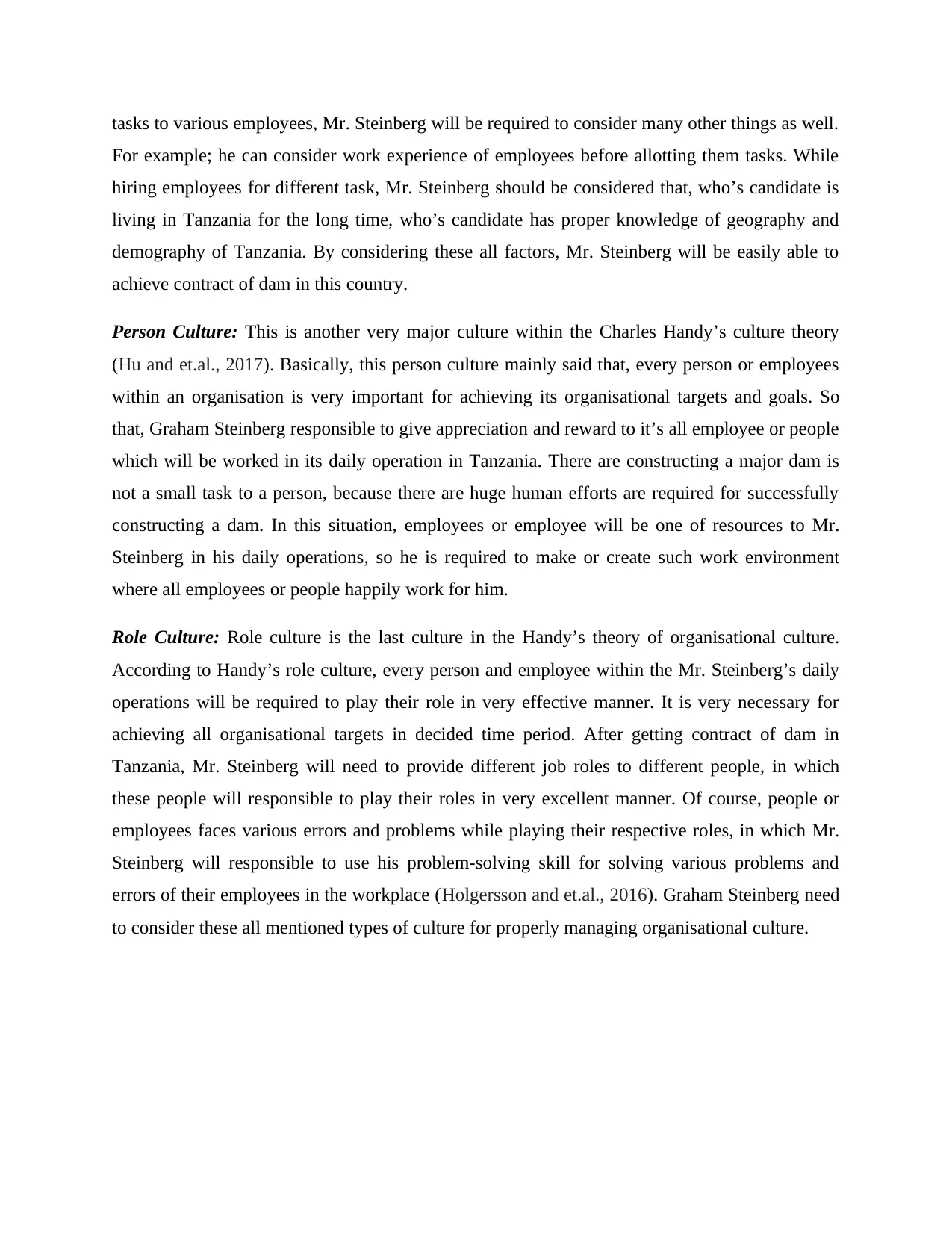
tasks to various employees, Mr. Steinberg will be required to consider many other things as well.
For example; he can consider work experience of employees before allotting them tasks. While
hiring employees for different task, Mr. Steinberg should be considered that, who’s candidate is
living in Tanzania for the long time, who’s candidate has proper knowledge of geography and
demography of Tanzania. By considering these all factors, Mr. Steinberg will be easily able to
achieve contract of dam in this country.
Person Culture: This is another very major culture within the Charles Handy’s culture theory
(Hu and et.al., 2017). Basically, this person culture mainly said that, every person or employees
within an organisation is very important for achieving its organisational targets and goals. So
that, Graham Steinberg responsible to give appreciation and reward to it’s all employee or people
which will be worked in its daily operation in Tanzania. There are constructing a major dam is
not a small task to a person, because there are huge human efforts are required for successfully
constructing a dam. In this situation, employees or employee will be one of resources to Mr.
Steinberg in his daily operations, so he is required to make or create such work environment
where all employees or people happily work for him.
Role Culture: Role culture is the last culture in the Handy’s theory of organisational culture.
According to Handy’s role culture, every person and employee within the Mr. Steinberg’s daily
operations will be required to play their role in very effective manner. It is very necessary for
achieving all organisational targets in decided time period. After getting contract of dam in
Tanzania, Mr. Steinberg will need to provide different job roles to different people, in which
these people will responsible to play their roles in very excellent manner. Of course, people or
employees faces various errors and problems while playing their respective roles, in which Mr.
Steinberg will responsible to use his problem-solving skill for solving various problems and
errors of their employees in the workplace (Holgersson and et.al., 2016). Graham Steinberg need
to consider these all mentioned types of culture for properly managing organisational culture.
For example; he can consider work experience of employees before allotting them tasks. While
hiring employees for different task, Mr. Steinberg should be considered that, who’s candidate is
living in Tanzania for the long time, who’s candidate has proper knowledge of geography and
demography of Tanzania. By considering these all factors, Mr. Steinberg will be easily able to
achieve contract of dam in this country.
Person Culture: This is another very major culture within the Charles Handy’s culture theory
(Hu and et.al., 2017). Basically, this person culture mainly said that, every person or employees
within an organisation is very important for achieving its organisational targets and goals. So
that, Graham Steinberg responsible to give appreciation and reward to it’s all employee or people
which will be worked in its daily operation in Tanzania. There are constructing a major dam is
not a small task to a person, because there are huge human efforts are required for successfully
constructing a dam. In this situation, employees or employee will be one of resources to Mr.
Steinberg in his daily operations, so he is required to make or create such work environment
where all employees or people happily work for him.
Role Culture: Role culture is the last culture in the Handy’s theory of organisational culture.
According to Handy’s role culture, every person and employee within the Mr. Steinberg’s daily
operations will be required to play their role in very effective manner. It is very necessary for
achieving all organisational targets in decided time period. After getting contract of dam in
Tanzania, Mr. Steinberg will need to provide different job roles to different people, in which
these people will responsible to play their roles in very excellent manner. Of course, people or
employees faces various errors and problems while playing their respective roles, in which Mr.
Steinberg will responsible to use his problem-solving skill for solving various problems and
errors of their employees in the workplace (Holgersson and et.al., 2016). Graham Steinberg need
to consider these all mentioned types of culture for properly managing organisational culture.
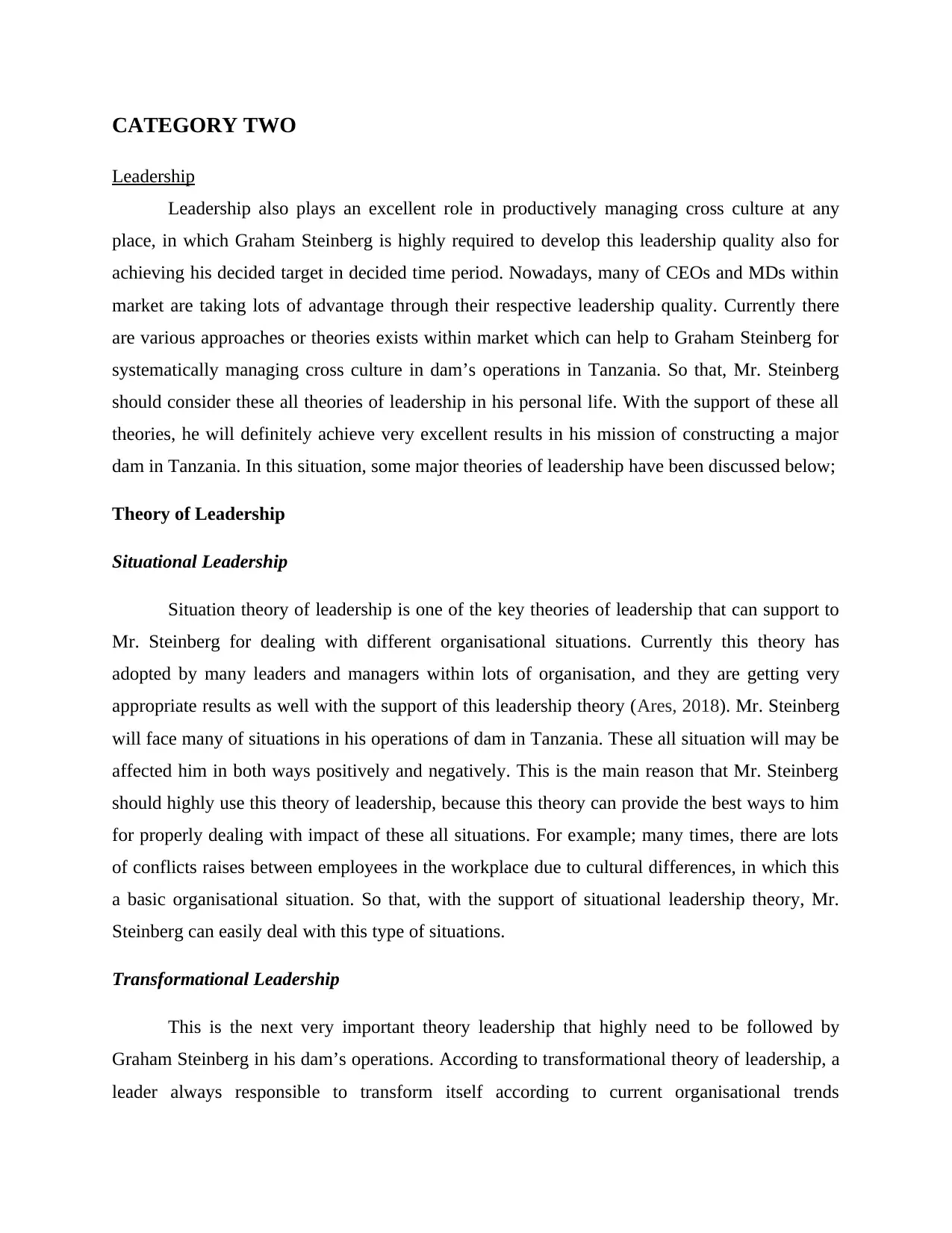
CATEGORY TWO
Leadership
Leadership also plays an excellent role in productively managing cross culture at any
place, in which Graham Steinberg is highly required to develop this leadership quality also for
achieving his decided target in decided time period. Nowadays, many of CEOs and MDs within
market are taking lots of advantage through their respective leadership quality. Currently there
are various approaches or theories exists within market which can help to Graham Steinberg for
systematically managing cross culture in dam’s operations in Tanzania. So that, Mr. Steinberg
should consider these all theories of leadership in his personal life. With the support of these all
theories, he will definitely achieve very excellent results in his mission of constructing a major
dam in Tanzania. In this situation, some major theories of leadership have been discussed below;
Theory of Leadership
Situational Leadership
Situation theory of leadership is one of the key theories of leadership that can support to
Mr. Steinberg for dealing with different organisational situations. Currently this theory has
adopted by many leaders and managers within lots of organisation, and they are getting very
appropriate results as well with the support of this leadership theory (Ares, 2018). Mr. Steinberg
will face many of situations in his operations of dam in Tanzania. These all situation will may be
affected him in both ways positively and negatively. This is the main reason that Mr. Steinberg
should highly use this theory of leadership, because this theory can provide the best ways to him
for properly dealing with impact of these all situations. For example; many times, there are lots
of conflicts raises between employees in the workplace due to cultural differences, in which this
a basic organisational situation. So that, with the support of situational leadership theory, Mr.
Steinberg can easily deal with this type of situations.
Transformational Leadership
This is the next very important theory leadership that highly need to be followed by
Graham Steinberg in his dam’s operations. According to transformational theory of leadership, a
leader always responsible to transform itself according to current organisational trends
Leadership
Leadership also plays an excellent role in productively managing cross culture at any
place, in which Graham Steinberg is highly required to develop this leadership quality also for
achieving his decided target in decided time period. Nowadays, many of CEOs and MDs within
market are taking lots of advantage through their respective leadership quality. Currently there
are various approaches or theories exists within market which can help to Graham Steinberg for
systematically managing cross culture in dam’s operations in Tanzania. So that, Mr. Steinberg
should consider these all theories of leadership in his personal life. With the support of these all
theories, he will definitely achieve very excellent results in his mission of constructing a major
dam in Tanzania. In this situation, some major theories of leadership have been discussed below;
Theory of Leadership
Situational Leadership
Situation theory of leadership is one of the key theories of leadership that can support to
Mr. Steinberg for dealing with different organisational situations. Currently this theory has
adopted by many leaders and managers within lots of organisation, and they are getting very
appropriate results as well with the support of this leadership theory (Ares, 2018). Mr. Steinberg
will face many of situations in his operations of dam in Tanzania. These all situation will may be
affected him in both ways positively and negatively. This is the main reason that Mr. Steinberg
should highly use this theory of leadership, because this theory can provide the best ways to him
for properly dealing with impact of these all situations. For example; many times, there are lots
of conflicts raises between employees in the workplace due to cultural differences, in which this
a basic organisational situation. So that, with the support of situational leadership theory, Mr.
Steinberg can easily deal with this type of situations.
Transformational Leadership
This is the next very important theory leadership that highly need to be followed by
Graham Steinberg in his dam’s operations. According to transformational theory of leadership, a
leader always responsible to transform itself according to current organisational trends
⊘ This is a preview!⊘
Do you want full access?
Subscribe today to unlock all pages.

Trusted by 1+ million students worldwide
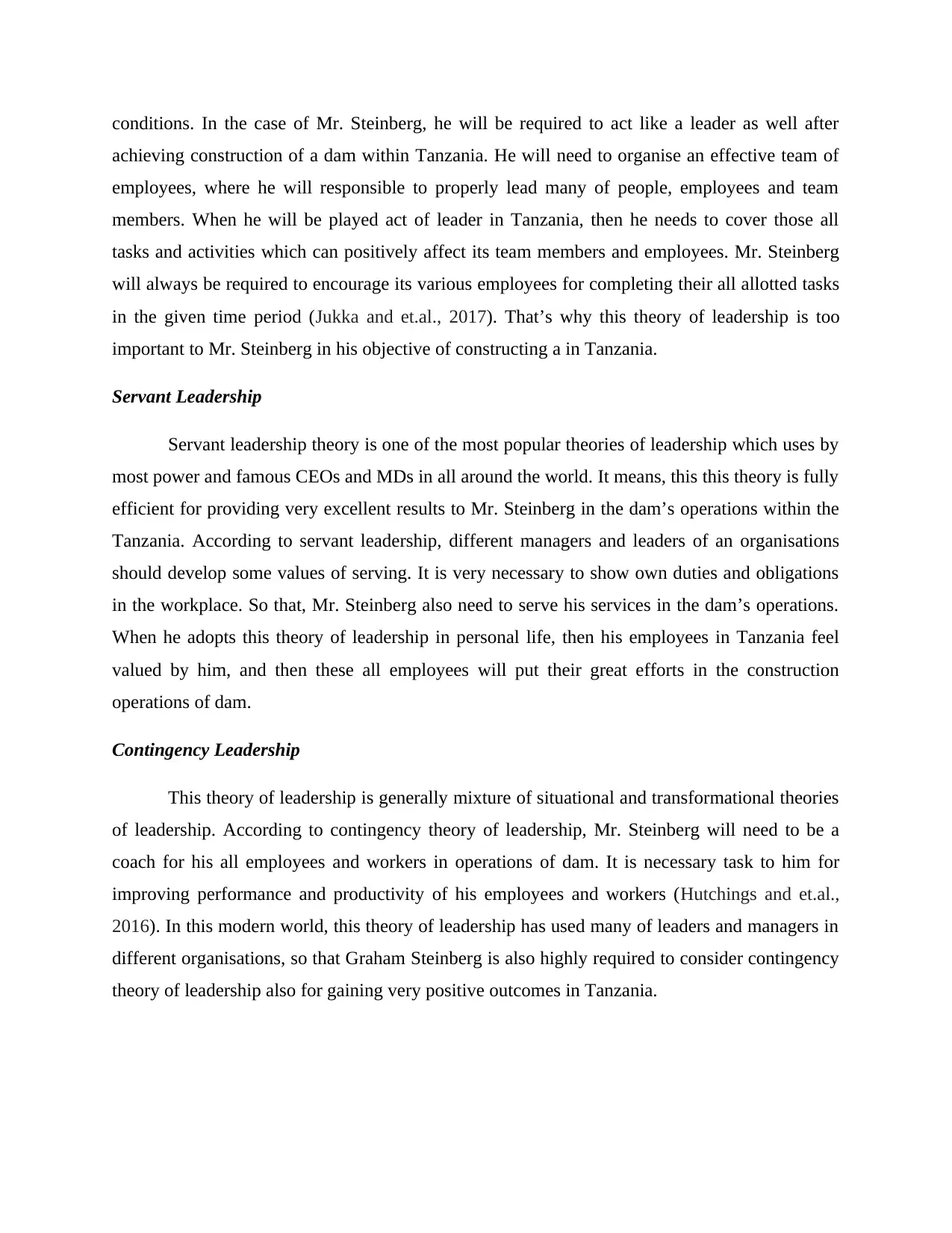
conditions. In the case of Mr. Steinberg, he will be required to act like a leader as well after
achieving construction of a dam within Tanzania. He will need to organise an effective team of
employees, where he will responsible to properly lead many of people, employees and team
members. When he will be played act of leader in Tanzania, then he needs to cover those all
tasks and activities which can positively affect its team members and employees. Mr. Steinberg
will always be required to encourage its various employees for completing their all allotted tasks
in the given time period (Jukka and et.al., 2017). That’s why this theory of leadership is too
important to Mr. Steinberg in his objective of constructing a in Tanzania.
Servant Leadership
Servant leadership theory is one of the most popular theories of leadership which uses by
most power and famous CEOs and MDs in all around the world. It means, this this theory is fully
efficient for providing very excellent results to Mr. Steinberg in the dam’s operations within the
Tanzania. According to servant leadership, different managers and leaders of an organisations
should develop some values of serving. It is very necessary to show own duties and obligations
in the workplace. So that, Mr. Steinberg also need to serve his services in the dam’s operations.
When he adopts this theory of leadership in personal life, then his employees in Tanzania feel
valued by him, and then these all employees will put their great efforts in the construction
operations of dam.
Contingency Leadership
This theory of leadership is generally mixture of situational and transformational theories
of leadership. According to contingency theory of leadership, Mr. Steinberg will need to be a
coach for his all employees and workers in operations of dam. It is necessary task to him for
improving performance and productivity of his employees and workers (Hutchings and et.al.,
2016). In this modern world, this theory of leadership has used many of leaders and managers in
different organisations, so that Graham Steinberg is also highly required to consider contingency
theory of leadership also for gaining very positive outcomes in Tanzania.
achieving construction of a dam within Tanzania. He will need to organise an effective team of
employees, where he will responsible to properly lead many of people, employees and team
members. When he will be played act of leader in Tanzania, then he needs to cover those all
tasks and activities which can positively affect its team members and employees. Mr. Steinberg
will always be required to encourage its various employees for completing their all allotted tasks
in the given time period (Jukka and et.al., 2017). That’s why this theory of leadership is too
important to Mr. Steinberg in his objective of constructing a in Tanzania.
Servant Leadership
Servant leadership theory is one of the most popular theories of leadership which uses by
most power and famous CEOs and MDs in all around the world. It means, this this theory is fully
efficient for providing very excellent results to Mr. Steinberg in the dam’s operations within the
Tanzania. According to servant leadership, different managers and leaders of an organisations
should develop some values of serving. It is very necessary to show own duties and obligations
in the workplace. So that, Mr. Steinberg also need to serve his services in the dam’s operations.
When he adopts this theory of leadership in personal life, then his employees in Tanzania feel
valued by him, and then these all employees will put their great efforts in the construction
operations of dam.
Contingency Leadership
This theory of leadership is generally mixture of situational and transformational theories
of leadership. According to contingency theory of leadership, Mr. Steinberg will need to be a
coach for his all employees and workers in operations of dam. It is necessary task to him for
improving performance and productivity of his employees and workers (Hutchings and et.al.,
2016). In this modern world, this theory of leadership has used many of leaders and managers in
different organisations, so that Graham Steinberg is also highly required to consider contingency
theory of leadership also for gaining very positive outcomes in Tanzania.
Paraphrase This Document
Need a fresh take? Get an instant paraphrase of this document with our AI Paraphraser
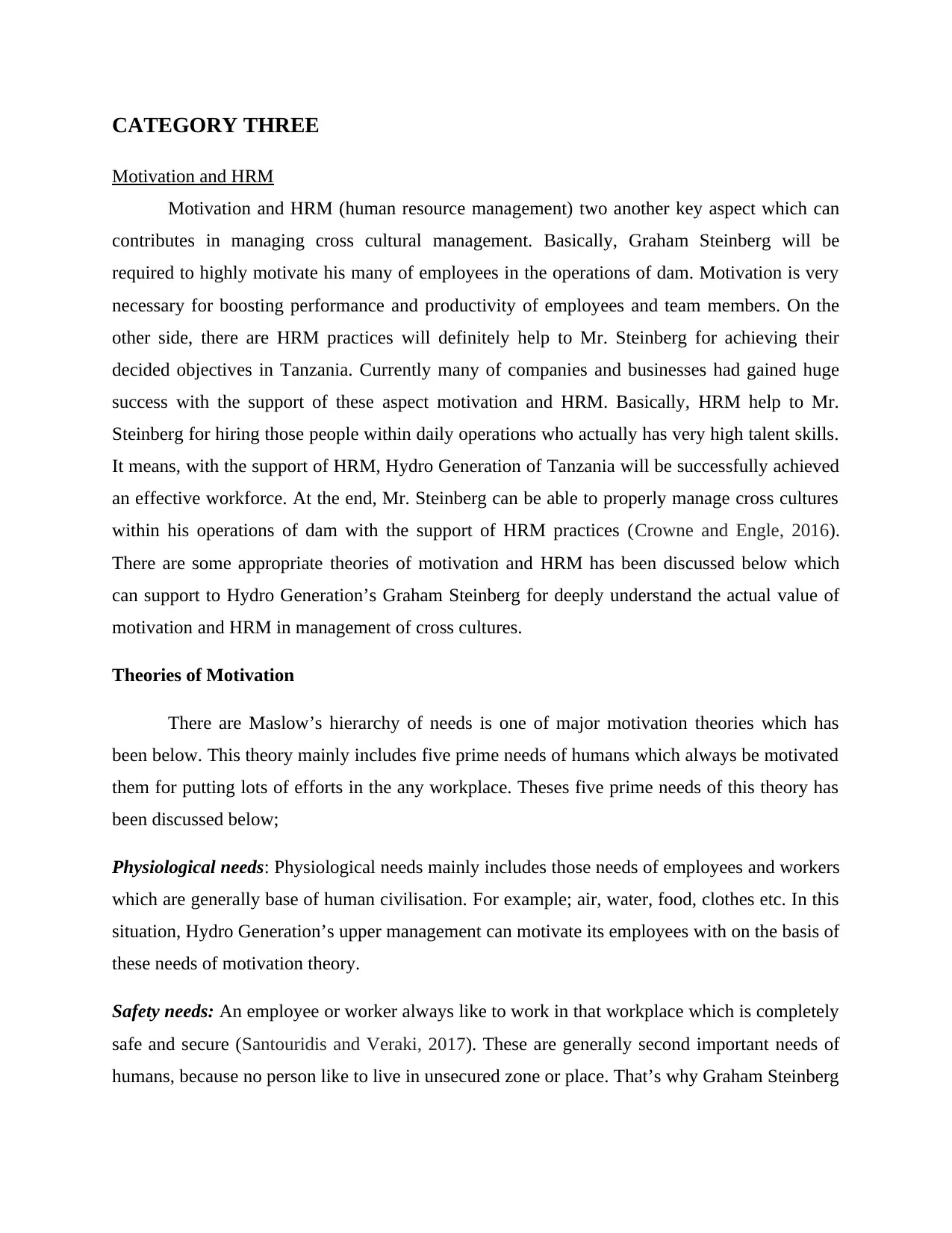
CATEGORY THREE
Motivation and HRM
Motivation and HRM (human resource management) two another key aspect which can
contributes in managing cross cultural management. Basically, Graham Steinberg will be
required to highly motivate his many of employees in the operations of dam. Motivation is very
necessary for boosting performance and productivity of employees and team members. On the
other side, there are HRM practices will definitely help to Mr. Steinberg for achieving their
decided objectives in Tanzania. Currently many of companies and businesses had gained huge
success with the support of these aspect motivation and HRM. Basically, HRM help to Mr.
Steinberg for hiring those people within daily operations who actually has very high talent skills.
It means, with the support of HRM, Hydro Generation of Tanzania will be successfully achieved
an effective workforce. At the end, Mr. Steinberg can be able to properly manage cross cultures
within his operations of dam with the support of HRM practices (Crowne and Engle, 2016).
There are some appropriate theories of motivation and HRM has been discussed below which
can support to Hydro Generation’s Graham Steinberg for deeply understand the actual value of
motivation and HRM in management of cross cultures.
Theories of Motivation
There are Maslow’s hierarchy of needs is one of major motivation theories which has
been below. This theory mainly includes five prime needs of humans which always be motivated
them for putting lots of efforts in the any workplace. Theses five prime needs of this theory has
been discussed below;
Physiological needs: Physiological needs mainly includes those needs of employees and workers
which are generally base of human civilisation. For example; air, water, food, clothes etc. In this
situation, Hydro Generation’s upper management can motivate its employees with on the basis of
these needs of motivation theory.
Safety needs: An employee or worker always like to work in that workplace which is completely
safe and secure (Santouridis and Veraki, 2017). These are generally second important needs of
humans, because no person like to live in unsecured zone or place. That’s why Graham Steinberg
Motivation and HRM
Motivation and HRM (human resource management) two another key aspect which can
contributes in managing cross cultural management. Basically, Graham Steinberg will be
required to highly motivate his many of employees in the operations of dam. Motivation is very
necessary for boosting performance and productivity of employees and team members. On the
other side, there are HRM practices will definitely help to Mr. Steinberg for achieving their
decided objectives in Tanzania. Currently many of companies and businesses had gained huge
success with the support of these aspect motivation and HRM. Basically, HRM help to Mr.
Steinberg for hiring those people within daily operations who actually has very high talent skills.
It means, with the support of HRM, Hydro Generation of Tanzania will be successfully achieved
an effective workforce. At the end, Mr. Steinberg can be able to properly manage cross cultures
within his operations of dam with the support of HRM practices (Crowne and Engle, 2016).
There are some appropriate theories of motivation and HRM has been discussed below which
can support to Hydro Generation’s Graham Steinberg for deeply understand the actual value of
motivation and HRM in management of cross cultures.
Theories of Motivation
There are Maslow’s hierarchy of needs is one of major motivation theories which has
been below. This theory mainly includes five prime needs of humans which always be motivated
them for putting lots of efforts in the any workplace. Theses five prime needs of this theory has
been discussed below;
Physiological needs: Physiological needs mainly includes those needs of employees and workers
which are generally base of human civilisation. For example; air, water, food, clothes etc. In this
situation, Hydro Generation’s upper management can motivate its employees with on the basis of
these needs of motivation theory.
Safety needs: An employee or worker always like to work in that workplace which is completely
safe and secure (Santouridis and Veraki, 2017). These are generally second important needs of
humans, because no person like to live in unsecured zone or place. That’s why Graham Steinberg
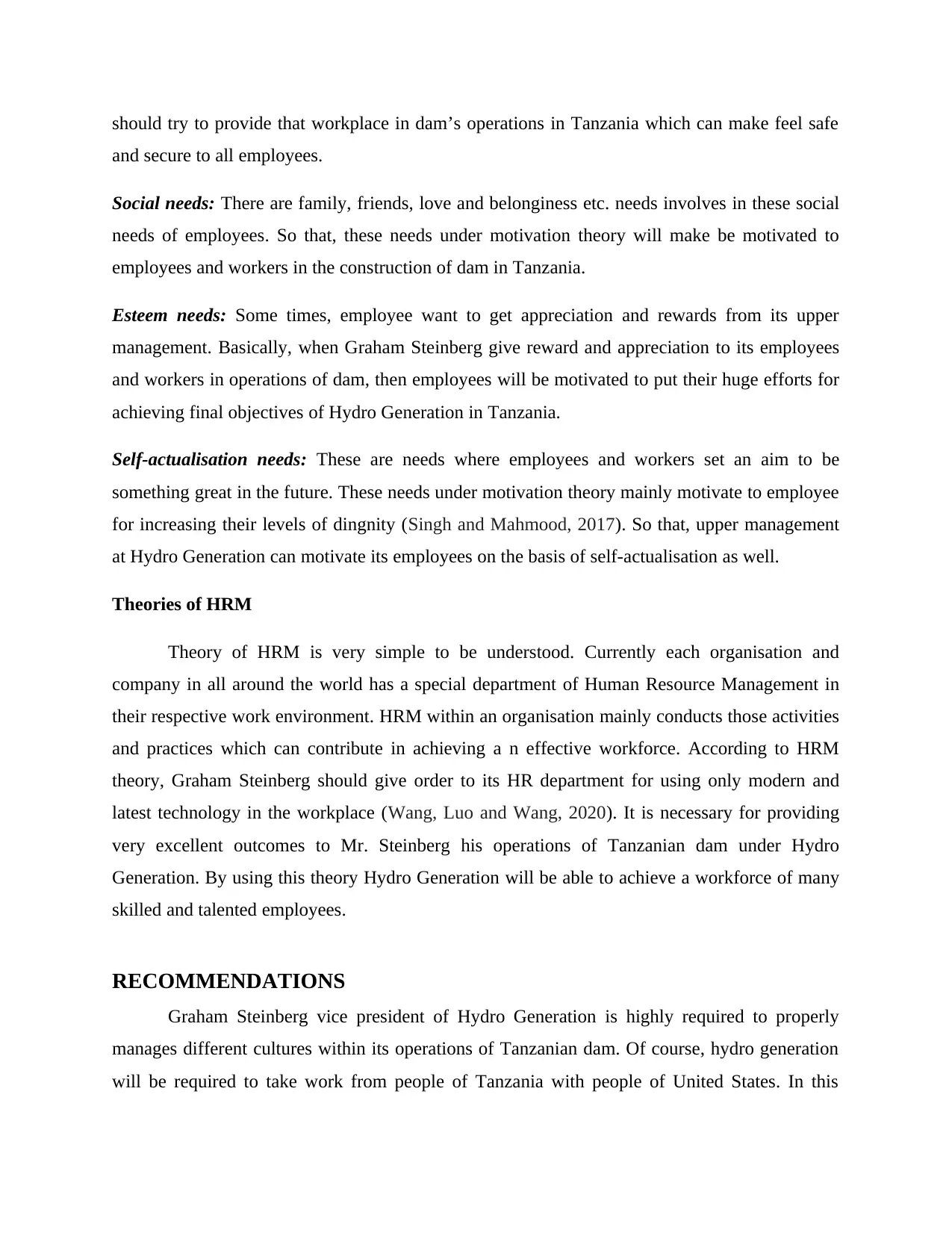
should try to provide that workplace in dam’s operations in Tanzania which can make feel safe
and secure to all employees.
Social needs: There are family, friends, love and belonginess etc. needs involves in these social
needs of employees. So that, these needs under motivation theory will make be motivated to
employees and workers in the construction of dam in Tanzania.
Esteem needs: Some times, employee want to get appreciation and rewards from its upper
management. Basically, when Graham Steinberg give reward and appreciation to its employees
and workers in operations of dam, then employees will be motivated to put their huge efforts for
achieving final objectives of Hydro Generation in Tanzania.
Self-actualisation needs: These are needs where employees and workers set an aim to be
something great in the future. These needs under motivation theory mainly motivate to employee
for increasing their levels of dingnity (Singh and Mahmood, 2017). So that, upper management
at Hydro Generation can motivate its employees on the basis of self-actualisation as well.
Theories of HRM
Theory of HRM is very simple to be understood. Currently each organisation and
company in all around the world has a special department of Human Resource Management in
their respective work environment. HRM within an organisation mainly conducts those activities
and practices which can contribute in achieving a n effective workforce. According to HRM
theory, Graham Steinberg should give order to its HR department for using only modern and
latest technology in the workplace (Wang, Luo and Wang, 2020). It is necessary for providing
very excellent outcomes to Mr. Steinberg his operations of Tanzanian dam under Hydro
Generation. By using this theory Hydro Generation will be able to achieve a workforce of many
skilled and talented employees.
RECOMMENDATIONS
Graham Steinberg vice president of Hydro Generation is highly required to properly
manages different cultures within its operations of Tanzanian dam. Of course, hydro generation
will be required to take work from people of Tanzania with people of United States. In this
and secure to all employees.
Social needs: There are family, friends, love and belonginess etc. needs involves in these social
needs of employees. So that, these needs under motivation theory will make be motivated to
employees and workers in the construction of dam in Tanzania.
Esteem needs: Some times, employee want to get appreciation and rewards from its upper
management. Basically, when Graham Steinberg give reward and appreciation to its employees
and workers in operations of dam, then employees will be motivated to put their huge efforts for
achieving final objectives of Hydro Generation in Tanzania.
Self-actualisation needs: These are needs where employees and workers set an aim to be
something great in the future. These needs under motivation theory mainly motivate to employee
for increasing their levels of dingnity (Singh and Mahmood, 2017). So that, upper management
at Hydro Generation can motivate its employees on the basis of self-actualisation as well.
Theories of HRM
Theory of HRM is very simple to be understood. Currently each organisation and
company in all around the world has a special department of Human Resource Management in
their respective work environment. HRM within an organisation mainly conducts those activities
and practices which can contribute in achieving a n effective workforce. According to HRM
theory, Graham Steinberg should give order to its HR department for using only modern and
latest technology in the workplace (Wang, Luo and Wang, 2020). It is necessary for providing
very excellent outcomes to Mr. Steinberg his operations of Tanzanian dam under Hydro
Generation. By using this theory Hydro Generation will be able to achieve a workforce of many
skilled and talented employees.
RECOMMENDATIONS
Graham Steinberg vice president of Hydro Generation is highly required to properly
manages different cultures within its operations of Tanzanian dam. Of course, hydro generation
will be required to take work from people of Tanzania with people of United States. In this
⊘ This is a preview!⊘
Do you want full access?
Subscribe today to unlock all pages.

Trusted by 1+ million students worldwide
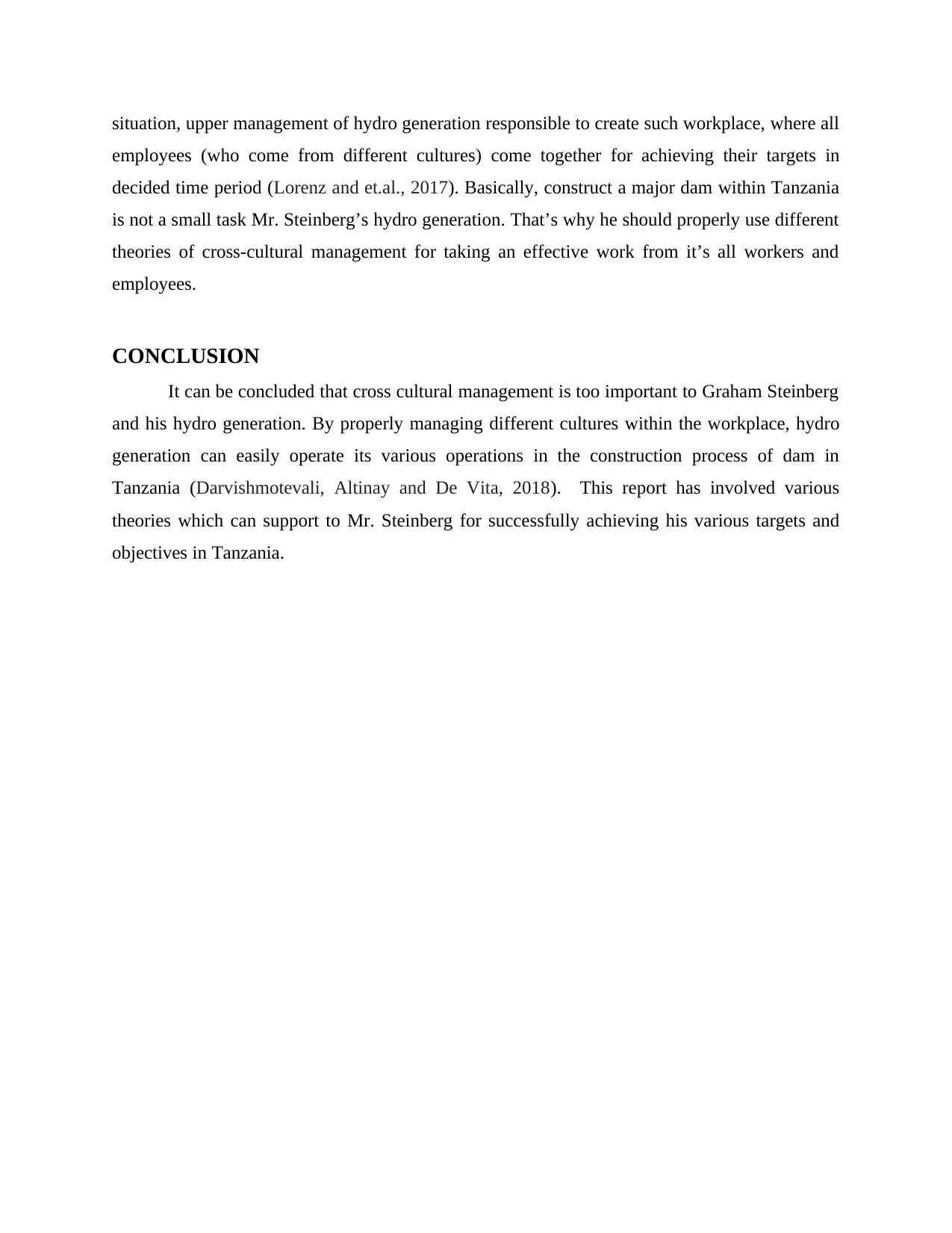
situation, upper management of hydro generation responsible to create such workplace, where all
employees (who come from different cultures) come together for achieving their targets in
decided time period (Lorenz and et.al., 2017). Basically, construct a major dam within Tanzania
is not a small task Mr. Steinberg’s hydro generation. That’s why he should properly use different
theories of cross-cultural management for taking an effective work from it’s all workers and
employees.
CONCLUSION
It can be concluded that cross cultural management is too important to Graham Steinberg
and his hydro generation. By properly managing different cultures within the workplace, hydro
generation can easily operate its various operations in the construction process of dam in
Tanzania (Darvishmotevali, Altinay and De Vita, 2018). This report has involved various
theories which can support to Mr. Steinberg for successfully achieving his various targets and
objectives in Tanzania.
employees (who come from different cultures) come together for achieving their targets in
decided time period (Lorenz and et.al., 2017). Basically, construct a major dam within Tanzania
is not a small task Mr. Steinberg’s hydro generation. That’s why he should properly use different
theories of cross-cultural management for taking an effective work from it’s all workers and
employees.
CONCLUSION
It can be concluded that cross cultural management is too important to Graham Steinberg
and his hydro generation. By properly managing different cultures within the workplace, hydro
generation can easily operate its various operations in the construction process of dam in
Tanzania (Darvishmotevali, Altinay and De Vita, 2018). This report has involved various
theories which can support to Mr. Steinberg for successfully achieving his various targets and
objectives in Tanzania.
Paraphrase This Document
Need a fresh take? Get an instant paraphrase of this document with our AI Paraphraser
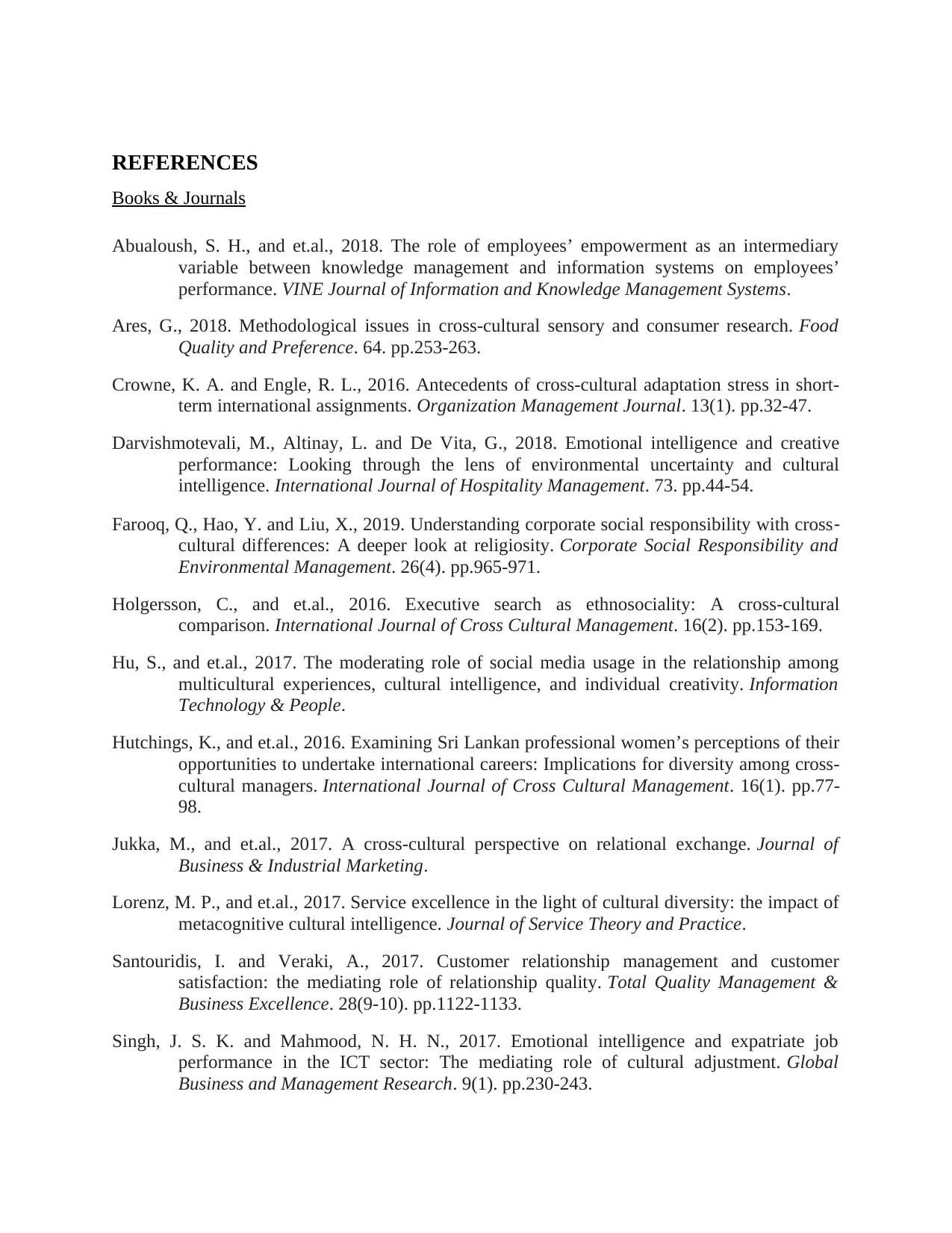
REFERENCES
Books & Journals
Abualoush, S. H., and et.al., 2018. The role of employees’ empowerment as an intermediary
variable between knowledge management and information systems on employees’
performance. VINE Journal of Information and Knowledge Management Systems.
Ares, G., 2018. Methodological issues in cross-cultural sensory and consumer research. Food
Quality and Preference. 64. pp.253-263.
Crowne, K. A. and Engle, R. L., 2016. Antecedents of cross-cultural adaptation stress in short-
term international assignments. Organization Management Journal. 13(1). pp.32-47.
Darvishmotevali, M., Altinay, L. and De Vita, G., 2018. Emotional intelligence and creative
performance: Looking through the lens of environmental uncertainty and cultural
intelligence. International Journal of Hospitality Management. 73. pp.44-54.
Farooq, Q., Hao, Y. and Liu, X., 2019. Understanding corporate social responsibility with cross‐
cultural differences: A deeper look at religiosity. Corporate Social Responsibility and
Environmental Management. 26(4). pp.965-971.
Holgersson, C., and et.al., 2016. Executive search as ethnosociality: A cross-cultural
comparison. International Journal of Cross Cultural Management. 16(2). pp.153-169.
Hu, S., and et.al., 2017. The moderating role of social media usage in the relationship among
multicultural experiences, cultural intelligence, and individual creativity. Information
Technology & People.
Hutchings, K., and et.al., 2016. Examining Sri Lankan professional women’s perceptions of their
opportunities to undertake international careers: Implications for diversity among cross-
cultural managers. International Journal of Cross Cultural Management. 16(1). pp.77-
98.
Jukka, M., and et.al., 2017. A cross-cultural perspective on relational exchange. Journal of
Business & Industrial Marketing.
Lorenz, M. P., and et.al., 2017. Service excellence in the light of cultural diversity: the impact of
metacognitive cultural intelligence. Journal of Service Theory and Practice.
Santouridis, I. and Veraki, A., 2017. Customer relationship management and customer
satisfaction: the mediating role of relationship quality. Total Quality Management &
Business Excellence. 28(9-10). pp.1122-1133.
Singh, J. S. K. and Mahmood, N. H. N., 2017. Emotional intelligence and expatriate job
performance in the ICT sector: The mediating role of cultural adjustment. Global
Business and Management Research. 9(1). pp.230-243.
Books & Journals
Abualoush, S. H., and et.al., 2018. The role of employees’ empowerment as an intermediary
variable between knowledge management and information systems on employees’
performance. VINE Journal of Information and Knowledge Management Systems.
Ares, G., 2018. Methodological issues in cross-cultural sensory and consumer research. Food
Quality and Preference. 64. pp.253-263.
Crowne, K. A. and Engle, R. L., 2016. Antecedents of cross-cultural adaptation stress in short-
term international assignments. Organization Management Journal. 13(1). pp.32-47.
Darvishmotevali, M., Altinay, L. and De Vita, G., 2018. Emotional intelligence and creative
performance: Looking through the lens of environmental uncertainty and cultural
intelligence. International Journal of Hospitality Management. 73. pp.44-54.
Farooq, Q., Hao, Y. and Liu, X., 2019. Understanding corporate social responsibility with cross‐
cultural differences: A deeper look at religiosity. Corporate Social Responsibility and
Environmental Management. 26(4). pp.965-971.
Holgersson, C., and et.al., 2016. Executive search as ethnosociality: A cross-cultural
comparison. International Journal of Cross Cultural Management. 16(2). pp.153-169.
Hu, S., and et.al., 2017. The moderating role of social media usage in the relationship among
multicultural experiences, cultural intelligence, and individual creativity. Information
Technology & People.
Hutchings, K., and et.al., 2016. Examining Sri Lankan professional women’s perceptions of their
opportunities to undertake international careers: Implications for diversity among cross-
cultural managers. International Journal of Cross Cultural Management. 16(1). pp.77-
98.
Jukka, M., and et.al., 2017. A cross-cultural perspective on relational exchange. Journal of
Business & Industrial Marketing.
Lorenz, M. P., and et.al., 2017. Service excellence in the light of cultural diversity: the impact of
metacognitive cultural intelligence. Journal of Service Theory and Practice.
Santouridis, I. and Veraki, A., 2017. Customer relationship management and customer
satisfaction: the mediating role of relationship quality. Total Quality Management &
Business Excellence. 28(9-10). pp.1122-1133.
Singh, J. S. K. and Mahmood, N. H. N., 2017. Emotional intelligence and expatriate job
performance in the ICT sector: The mediating role of cultural adjustment. Global
Business and Management Research. 9(1). pp.230-243.
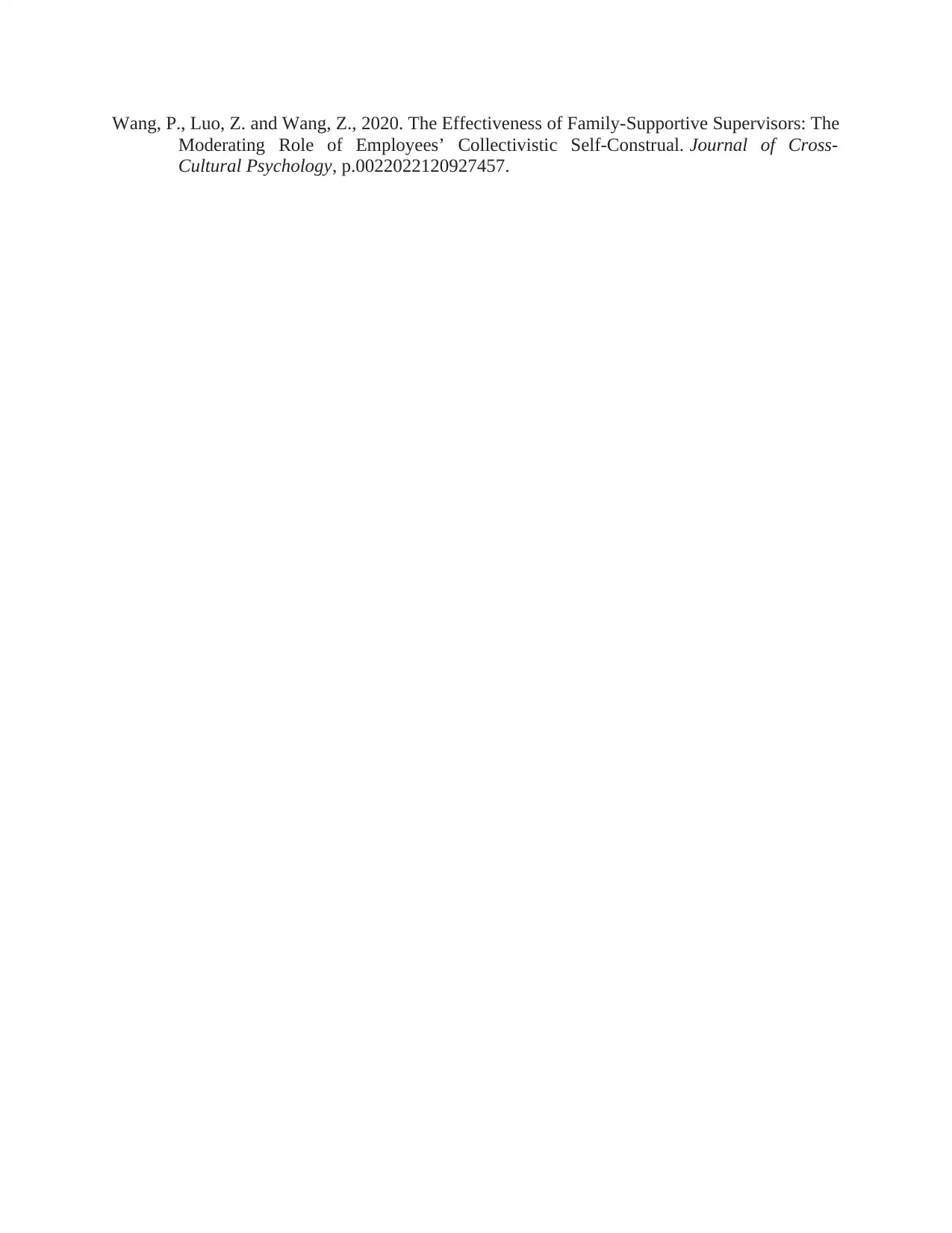
Wang, P., Luo, Z. and Wang, Z., 2020. The Effectiveness of Family-Supportive Supervisors: The
Moderating Role of Employees’ Collectivistic Self-Construal. Journal of Cross-
Cultural Psychology, p.0022022120927457.
Moderating Role of Employees’ Collectivistic Self-Construal. Journal of Cross-
Cultural Psychology, p.0022022120927457.
⊘ This is a preview!⊘
Do you want full access?
Subscribe today to unlock all pages.

Trusted by 1+ million students worldwide
1 out of 12
Related Documents
Your All-in-One AI-Powered Toolkit for Academic Success.
+13062052269
info@desklib.com
Available 24*7 on WhatsApp / Email
![[object Object]](/_next/static/media/star-bottom.7253800d.svg)
Unlock your academic potential
Copyright © 2020–2025 A2Z Services. All Rights Reserved. Developed and managed by ZUCOL.





